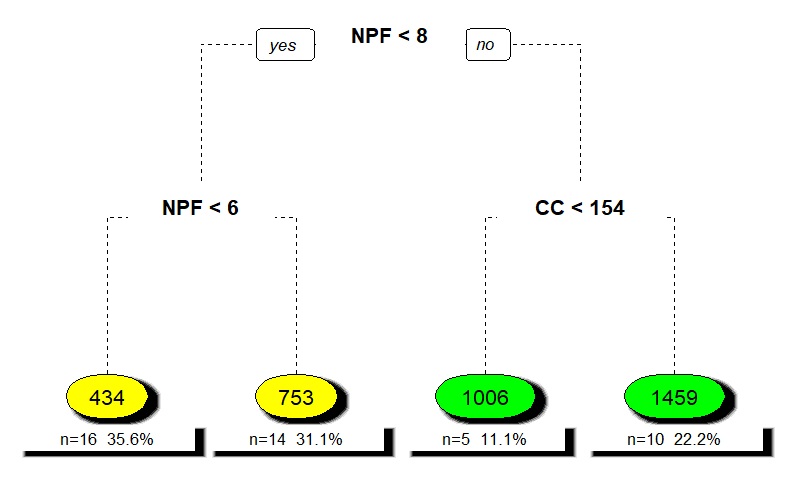Prediction of fresh and dry matter of the aerial part of the plant teosinte as a function of morphological traits
Keywords:
Zea mays ssp. mexicana, multiple linear regression, regression tree, forage plantAbstract
The objective of this work was to verify whether the fresh and dry matter of the aerial part of the teosinte plant can be estimated as a function of morphological traits. An experiment was conducted in the agricultural year 2021/2022, in nine sowing dates. The following morphological traits were measured: stem length of the main stem (CC, cm); length of the main stem tassel (CP, cm); number of leaves on the main stem (NF); and number of tillers of the plant (NPF) and the productive ones: fresh mass of the aerial part of the plant (MFPA, g) and dry mass of the aerial part of the plant (MSPA, g). The parameters of the multiple linear regression model and the coefficient of determination were estimated considering the variables MFPA and MSPA as dependent and the other (CC, CP, NF, NPF) as independent. The parameters of the regression tree algorithm for predicting MFPA and MSPA were estimated as a function of the other variables (CC, CP, NF, NPF). The fresh and dry mass of the aerial part of the teosinte plant can be estimated as a function of morphological characters. The MFPA can be estimated by the following regression model: MFPA= -740.42 + 3.38(CC) + 9.70(CP) + 41.05(NF) + 85.70(NPF). While the MSPA can be estimated by the following regression model: MSPA= -84.33 + 0.85(CC) + 0.27(CP) + 3.67(NF) + 19.46(NPF). Plants with NPF greater than 8 and CC greater than 154 cm show the highest production of MFPA and MSPA.
References
AHMAD, M. et al. Estimation of correlation coefficient in oats (Avena sativa L.) for forage yield, grain yield and their contributing traits. International Journal of Plant Breeding and Genetics, v. 7, n. 3, p. 188-191, 2013.
ALVARES, C. A. et al. Köppen’s climate classification map for Brazil. Meteorologische Zeitschrift, v. 22, n. 6, p. 711-728, 2013.
CARGNELUTTI FILHO, A. et al. Relações lineares entre caracteres de aveia preta. Ciência Rural, v. 45, n. 6, p. 985-992, 2015.
HAIR, J. F. et al. Análise multivariada de dados. 6. ed. Porto Alegre: Bookman, 2009, 688p.
JHA, A. K. et al. Impact of irrigation method on water use efficiency and productivity of fodder crops in Nepal. Climate, v. 4, n. 1, p. 1-13, 2016.
KHANAL, B. et al. Maximizing fodder yield of teosinte (Euchlaena mexicana) through sowing dates and mixed fodder cropping management. Journal of Agriculture and Forestry University, v. 4, p. 269-278, 2020.
KUMAR, B. et al. Herbage production, nutritional composition and quality of teosinte under Fe fertilization. International Journal of Agriculture & Biology, v. 18, n. 2, p. 319-329, 2016.
LOH, W. Y. Classification and regression trees. Wiley Interdisciplinary Reviews: Data Mining and Knowledge Discovery, v. 1, n. 1, p. 14-23, 2011.
MILBORROW, S. _rpart.plot: Plot ´rpart` Models: an Enhanced Version of ´plot.rpart`_. R package version 3.1.1, 2022. <https://CRAN.R-project.org/package=rpart.plot>.
MOHAN, S.; DAR, E. A.; SINGH, M. Fodder quality of teosinte fodder as influenced by nitrogen, phosphorus and zinc application. International Journal of Pure and Applied Bioscience, v. 5, p. 596-604, 2017.
ORTIZ, V. M. et al. Correlação e análise de trilha entre caracteres de teosinto. Sigmae, v. 12, n. 1, p. 29-39, 2023.
R CORE TEAM. R: A Language and Environment for Statistical Computing. R Foundation for Statistical Computing, Vienna, Austria, 2023. URL https://www.R-project.org/.
SANTOS, H. G. et al. Sistema Brasileiro de Classificação de Solos. 5. ed. Brasília: Embrapa. p. 356, 2018.
THERNEAU, T.; ATKINSON, B. _rpart: Recursive Partitioning and Regression Trees_. R package version 4.1.19, 2022. <https://CRAN.R-project.org/package=rpart>

Downloads
Published
How to Cite
Issue
Section
License
Proposta de Política para Periódicos de Acesso Livre
Autores que publicam nesta revista concordam com os seguintes termos:
- Autores mantém os direitos autorais e concedem à revista o direito de primeira publicação, com o trabalho simultaneamente licenciado sob a Licença Creative Commons Attribution que permite o compartilhamento do trabalho com reconhecimento da autoria e publicação inicial nesta revista.
- Autores têm autorização para assumir contratos adicionais separadamente, para distribuição não-exclusiva da versão do trabalho publicada nesta revista (ex.: publicar em repositório institucional ou como capítulo de livro), com reconhecimento de autoria e publicação inicial nesta revista.
- Autores têm permissão e são estimulados a publicar e distribuir seu trabalho online (ex.: em repositórios institucionais ou na sua página pessoal) a qualquer ponto antes ou durante o processo editorial, já que isso pode gerar alterações produtivas, bem como aumentar o impacto e a citação do trabalho publicado (Veja O Efeito do Acesso Livre).
